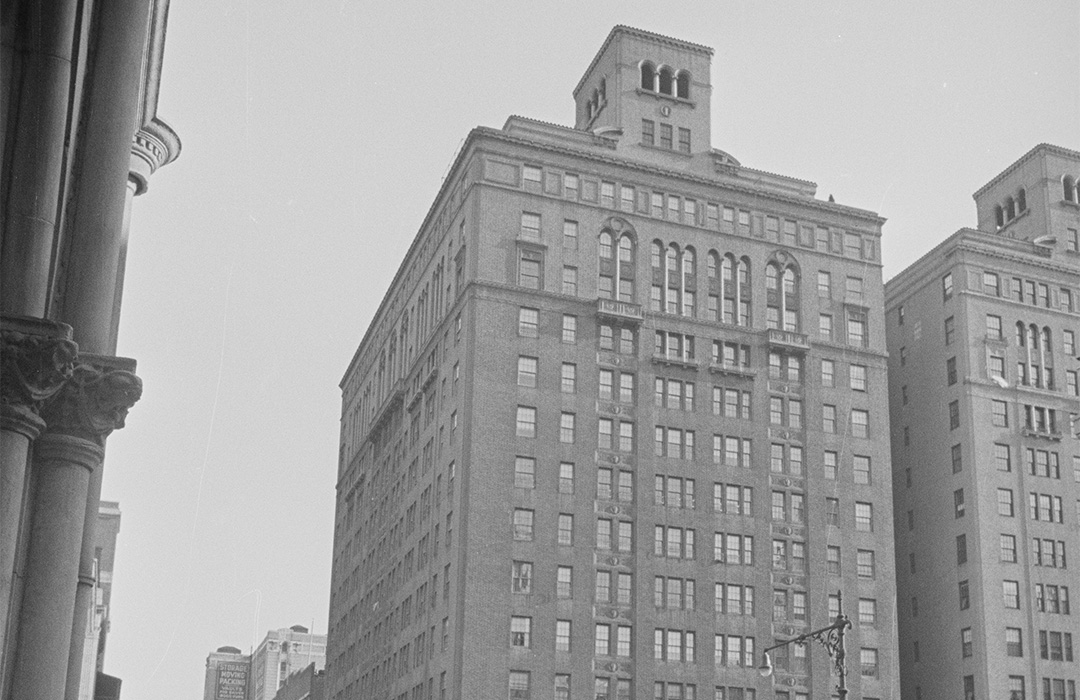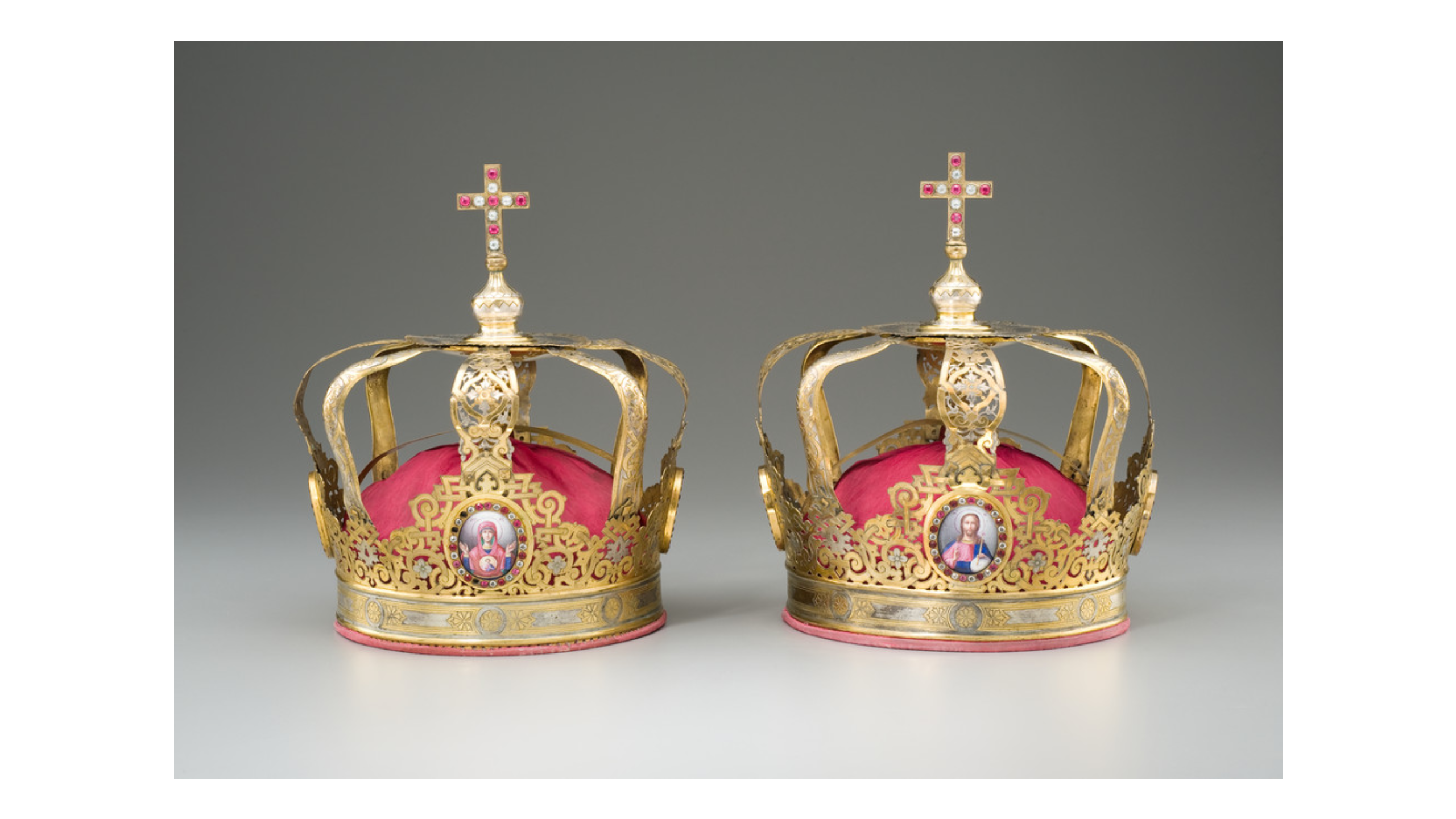
The Manhill
by Tom Miller
Real Estate developer Sam Minskoff was apparently well-pleased with the Myron Arms—the 14-story apartment building designed by Emery Roth in 1922 on the northeast corner of Broadway and 82nd Street. The following year he rehired Roth, directing him to design a nearly identical building on the northern corner, to be named the Jerome Palace. The two fraternal twins filled the Broadway block between 82nd and 83rd Streets, their Renaissance Revival designs, Italian-style balconies, and two-story towers creating an imposing presence.
The Jerome Palace was completed in 1924 and filled with financially-comfortable tenants like Adolph Held, the first vice-president of the Amalgamated Bank of New York, and well-to-do jeweler Rudolph Oblatt.
Oblatt, whose store was at 527 Fifth Avenue, was a partner with Norman C. Weiss. In 1926 Weiss made several trips to Moscow to negotiate the purchase of jewels previously owned by Russian royalty, now property of the Soviet State. His work paid off. On November 15, The New York Times reported, “Some American woman soon will have the chance to wear the crown of Catherine the Great of Russia—if she wants it and can afford it.” The article went on to say that Weiss had not only purchased the crown worn on Catherine’s wedding day to Peter III, but a solid gold baby rattle used by Czar Nicholas, a diamond-studded sword once owned by Czar Paul I, “the mad monarch,” and many other valuable and historic pieces.
A reporter arrived at Oblatt’s apartment on November 14, but the jeweler was unable or unwilling to give many details on the transaction. He did say, however, that the items would be placed on the market “soon,” and “if there is no American woman rich enough to purchase Catherine’s crown and the other gems,” they would be broken apart and sold separately. (Happily, the nuptial crown sits safely today in the Hillwood Museum.)
“if there is no American woman rich enough to purchase Catherine’s crown and the other gems,” they would be broken apart and sold separately.
By the early 1930’s, Dr. Melchiorre Mauro-Cottione and his wife Rose lived in the Jerome Palace. Born in Palermo, Italy, he became the organist of the Church of San Carlo Borromeo there when he was just 12 years old. He assisted his father, Antonio Mauro, as organist and choir master at the Pantheon, Church of the Dominican Fathers, and as a teacher at the Royal Conservatory. At the age of 18, he became director of the Schola Cantorum Pius X.
Mauro-Cattione arrived in the United States in 1905 and five years later made his New York debut at Mendelssohn Hall. In the years that followed he would be organist and choirmaster in several churches, and conduct the Philadelphia Orchestra for the debut of Italian organist M. E. Bossi, and the Henry Savage Opera Company’s premier of The Girl of the Golden West. He was, as well, a noted composer for organ and choral music.
Perhaps the first tenants associated with the popular entertainment industry were Peggy and Tex Herman Weiner, who lived in the building by 1945. Tex worked for the Government’s Office of Price Administration, formed in 1941 to control prices and rents after the outbreak of World War II. He was a scriptwriter for the administration’s radio programs, including the 15-minute weekly “Soldiers With Coupons,” which Peggy co-produced. Writers had to be cautious in the 1940s. The Communist hearings that were going on sometimes echoed the witch trials in Massachusetts three centuries earlier. One false word or move could draw suspicion.
Tex Weiner drew that suspicion. When an office worker named Mrs. Talbot told him that she was a firm believer in God and the Bible, Weiner replied, “That book is the dirtiest, most immoral book ever written, and there are no clean women in it.” Rumors that Weiner was an atheist and a Communist quickly spread, resulting in his being summoned to appear before the Congressional Committee on Un-American Activities in June 1945.
Weiner was accused of “injecting Communist propaganda into the weekly program, Soldiers With Coupons.” On June 25, 1945, Broadcast Advertising reported, “On Wednesday the committee…first tried to prove the programs were defaming the Irish, then tried to see ‘Communist Line’ in alleging the scripts questioned the honest of American businessmen.” Weiner’s supervisors came to his defense, calling the committee’s investigation a “witch hunt.” In the end, Weiner was absolved of all accusations.
Living here in 1950 were public relations and advertising executive Maurice A. Bergman and his wife, the former Gertrude Feingold. Born in 1899, his first job after graduation from Ohio State University was managing the Ted Lewis Orchestra. In 1940 he was named advertising manager for Twentieth Century-Fox studios. A year after moving into 222 West 83rd Street, Bergman was appointed executive in charge of public relations for Universal-International Pictures. He retired in 1959, and in 1962 he and Gertrude left New York to live in San Carlos, California.
In the 1960s radio and television writer, director, and producer Ira Marion lived here with his wife Edith. He joined the staff of the American Broadcasting Company in 1945, where he wrote and produced documentaries, serials and dramatic programs. Aside from his work with ABC, he wrote and produced public service movies for the New York Fire Department and the Fresh Air Fund, and a series of radio shows called “Disaster” for the American Red Cross.
Rumors that Weiner was an atheist and a Communist quickly spread, resulting in his being summoned to appear before the Congressional Committee on Un-American Activities in June 1945.
A horrific mishap occurred here in 1995. Richard Marback was the president of MBL Communications, the publisher of the medical journal Primary Psychiatry. His wife Patricia was a respected stockbroker with Bear Stearns. The young, successful couple lived on the 14th floor with their two children, a 2-year-old son, and an 8-year-old daughter. The family was the picture of Upper West Side gentrification. On October 2, 1995, New York Magazine said their three-bedroom apartment with parquet floors cost $3,000 per month. It added:
Marback’s only manifest obsession was his kids. Each summer he’d devote one week of vacation to father-and-daughter time, just him and Tashi in the Hamptons. Marback was one of the earliest to arrive at his office and one of the first to leave, so he could relieve the baby-sitter.
Richard and Patricia Marback decided to be daring on the night of August 7, 1995. They put the children to bed, and then experimented with heroin, what Richard’s lawyer called an “isolated incident” and their first time to do so. It resulted in Patricia dying of an overdose and Richard’s being arrested with possession.
A devastated Richard Marback was placed in a drug treatment program. More than a year after the tragic incident, in December 1996, a Manhattan judge dismissed the drug charges against him.
Unlike many of the Broadway apartment buildings of the 1920s, the Jerome Palace—today known as the Manville—never declined. It continues to attract professional residents, just as it did in 1924.
Tom Miller is a social historian and blogger at daytoninmanhattan.blogspot.com
BUILDING DATABASE
Keep Exploring
Be a part of history!
Think Local First to support the businesses currently at 222 West 83rd Street aka 2290 Broadway:
Meet Rene Digal!
Meet Jay Strauss!



